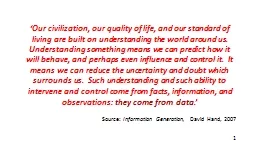PPT-‘Our civilization, our quality of life, and our standard of living are built on understanding
Author : marina-yarberry | Published Date : 2018-02-28
they come from data Source Information Generation David Hand 2007 Data Data Everywhere But Lets Just Stop and Think David J Hand We are on the cusp of a tremendous
Presentation Embed Code
Download Presentation
Download Presentation The PPT/PDF document "‘Our civilization, our quality of life..." is the property of its rightful owner. Permission is granted to download and print the materials on this website for personal, non-commercial use only, and to display it on your personal computer provided you do not modify the materials and that you retain all copyright notices contained in the materials. By downloading content from our website, you accept the terms of this agreement.
‘Our civilization, our quality of life, and our standard of living are built on understanding: Transcript
Download Rules Of Document
"‘Our civilization, our quality of life, and our standard of living are built on understanding"The content belongs to its owner. You may download and print it for personal use, without modification, and keep all copyright notices. By downloading, you agree to these terms.
Related Documents














